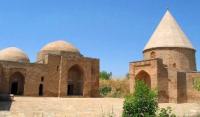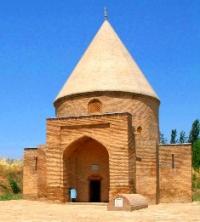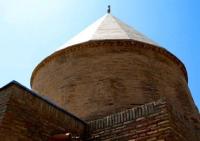You are here
Architectural and cult complex Turbat.



The architectural and religious in Turkestan.
“Even the models we see in magazines wish they could look like their own images”
Cheri K. Erdman.
A trip from Shymkent to Taraz.
The architectural and religious complex Turbat is dated to the XIII - XIX centuries, located in the Kazygurt district of the Turkestan region. The complex consists of the mausoleums of Ismail-Ata, Koshkar Ata, Zhabrail Ata and Yshak Ata, a mosque. In 2004, the restoration of the mausoleum of Ismail Ata was carried out.
Mazar Ismail-ata is located on the territory of the architectural and religious complex Turbat (XIII - XIX centuries) in the Kazygurt district in the South Kazakhstan region. Some 70 kilometres south of Shymkent is a beautiful village, again situated at the foot of a mountain.
This is Turbat, the aul of the rose growers. In summer, this place is surrounded by blooming rose fields, grown to produce rose oil. A large town existed here from the 6th to XVth centuries, and today you can visit the Ismail Ata protected monument consisting of a number of mausoleums and the mosque of Baba Ata.
While part of the walls date from ancient times, the main building has been completely rebuilt. The site is dedicated to the Prophet Baba Ata, who is supposed to have worked here. Mazar Ismail-ata is a monument of medieval architecture.
This is a portal domed building with a tent covering. In the construction of the mazar, burnt square brick on a ganch solution was used. The construction, traditional for the monumental architecture of Central Asia, was applied: a dome that overlaps the central room is based on four arches made in the plane of the walls, corner spaces are blocked by beams.
Fragments of gypsum plasters with traces of floral, geometric and epigraphic ornaments were revealed on the walls in the interior. In 2010, restoration work began, local residents took part in this. It was mastered 14 million tenge.
With this money, religious buildings were restored, a gibadathana was built with a height of five, a width of 14 and a length of 40 meters. The mausoleum of Dzhabrail-Ata is a portal-domed single-chamber building with the side of a square room.
The mausoleum is built of elongated burnt bricks of the "European type", on the site of the previously destroyed tomb of the saint. Only two facades, the south and the west, facing the alleys, were architecturally designed.
The south facade is built in the form of a portal with a large lancet niche in a U-shaped frame. The corners of the portal are flanked by three-quarter columns. The western facade is divided into 3 parts by pilasters-blades, each of which has a shallow niche.
The mausoleum of Dzhabrail-Ata is known and revered among the Muslim population and is used as an object of pilgrimage for scientific, religious and cultural - educational purposes. The mausoleum of Jabrail-Ata is an architectural monument.
Authority:
The guidebook across Kazakhstan . Authors Dagmar Schreiber and Jeremy Tredinnick. “Monuments of history and culture of Kazakhstan. Shymkent region. Volume 1. Alma-Ata. 1994 year. G.M. Kamalova.







